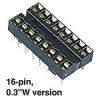Hi! I am doing a project and am having headaches.
I am doing a heartbeat monitor using **broken link removed**
1. Is there any difference between PIC16F84 and PIC16F84A?
2. I heard that the source code for PIC16F84 cannot be programmed to PIC16F84A. It will not work. Is that true?
3. The circuit is using PIC16F84-10/P. However, I am only using a 4MHz crystal in the circuit. Can I use PIC16F84-04/P?
Please advise! Thanks!
I am doing a heartbeat monitor using **broken link removed**
1. Is there any difference between PIC16F84 and PIC16F84A?
2. I heard that the source code for PIC16F84 cannot be programmed to PIC16F84A. It will not work. Is that true?
3. The circuit is using PIC16F84-10/P. However, I am only using a 4MHz crystal in the circuit. Can I use PIC16F84-04/P?
Please advise! Thanks!

